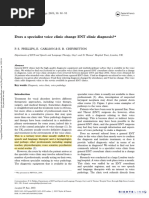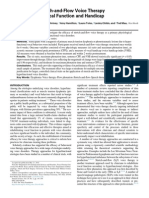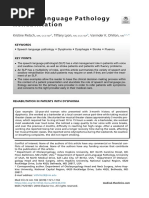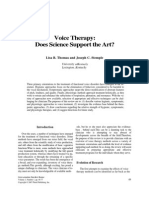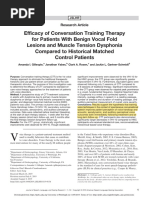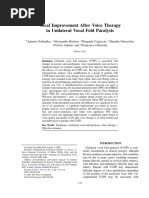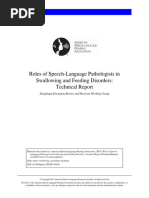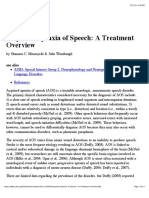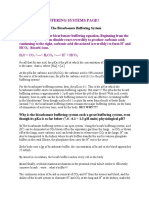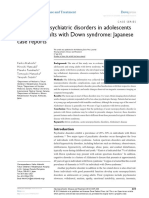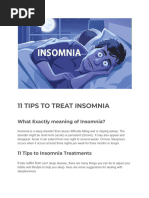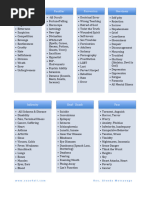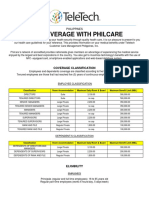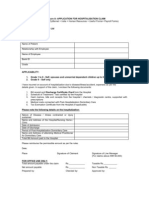Effectiveness of Speech Therapy in The Treatment of Vocal Fold Polyps
Effectiveness of Speech Therapy in The Treatment of Vocal Fold Polyps
Uploaded by
DANIELA IGNACIA FERNÁNDEZ LEÓNCopyright:
Available Formats
Effectiveness of Speech Therapy in The Treatment of Vocal Fold Polyps
Effectiveness of Speech Therapy in The Treatment of Vocal Fold Polyps
Uploaded by
DANIELA IGNACIA FERNÁNDEZ LEÓNOriginal Title
Copyright
Available Formats
Share this document
Did you find this document useful?
Is this content inappropriate?
Copyright:
Available Formats
Effectiveness of Speech Therapy in The Treatment of Vocal Fold Polyps
Effectiveness of Speech Therapy in The Treatment of Vocal Fold Polyps
Uploaded by
DANIELA IGNACIA FERNÁNDEZ LEÓNCopyright:
Available Formats
2009
EFFECTIVENESS OF SPEECH THERAPY
IN THE TREATMENT OF VOCAL FOLD POLYPS
Efetividade da fonoterapia no tratamento do pólipo em pregas vocais
Daniela de Vasconcelos (1), Adriana Oliveira de Camargo Gomes (1),
Cláudia Marina Tavares de Araújo (1)
ABSTRACT
The aim of this study was to verify the effectiveness of speech therapy in the treatment of vocal
fold polyps by reviewing existing literature. Literature search was conducted through PublicMedline
platform and the Scopus, Science Direct, Cumulative Index to Nursing and Allied Health Literature
and Web of Science databases, followed by critical pre-selection and deep analysis of the articles.
There were included original articles in which the speech therapy was used as treatment for vocal
polyp, no publication date or language restrictions. There were excluded studies addressing just
other treatments for vocal polyp and also articles in which the speech therapy was used only after
laryngeal surgery. A total of 905 articles were found. However, after the selection stages, only nine
articles were chosen to be part of the sample. The selected articles were fully analyzed, registered
through previously developed protocol. The articles analyzed in this study showed poor methodology
and lack of standardization regarding the speech therapy protocols and procedures used. It was
consisted mostly by retrospective case series. The sample of studies reviewed presented variation in
the number of participants, the type of lesion and type of polyp. The predominant type of intervention in
the studies was the direct and indirect speech therapy associated, which demonstrated effectiveness
in the treatment of polyps on the vocal folds. Speech therapy for the treatment of vocal fold polyps
demonstrated effectiveness between 30% and 100% of the analyzed studies, with better results in
small and recent polyps.
KEYWORDS: Laryngeal Diseases; Speech Therapy; Voice Training; Treatment Outcome
INTRODUCTION processes may collaborate to the appearance of
polyp, such as gastroesophageal reflux, aspiration
of aggressive chemical substances or intense
In speech therapy clinic, more specifically in
respiratory activities10. The main vocal symptoms
voice area, the most common laryngeal lesions are
presented are hoarseness and breathiness, besides
organofunctional lesions in vocal folds, especially
vocal fatigue7,11.
nodules and polyps, whose etiological factors are
The treatment normally adopted for this type of
directly related to inappropriate vocal behavior
vocal fold lesion is surgical12 despite pre-surgical
through bad use or abuse use of the voice1.
vocal speech therapy being considered efficient
Vocal fold polyps are lesions of benign mass, in aiding the regression of the edema associated
generally unilateral, which can be classified into to polyp and sub-adjacent areas, thus reducing
sessile or pendunculated in relation to form, or into the area of intervention during surgery10. Speech
gelatinous (translucent), fibrous (organized) and therapy is indicated after surgery with the purpose
angiomatous (hemorrhagic)2-8 in relation to histo- of adapting the vocal behavior in order to avoid
logical characteristics9. However, other irritation the relapse of the lesion13. However, some recent
studies highlight the importance of speech therapy
(1)
Universidade Federal de Pernambuco – UFPE – Recife as a primary treatment of polyp, with results of
(PE), Brasil. complete or partial regression of the lesion, followed
Conflict of interest: non-existent by the indication of surgery in situation persistent
Rev. CEFAC. 2015 Nov-Dez; 17(6):2009-2017
2010 Vasconcelos D, Gomes AOC, Araújo CMT
lesion and dissatisfaction regarding the resulting of vocal fold polyps through bibliographic research
vocal quality8,9,14-16. with updated scientific evidence.
Despite the increasing number of publications
and presentations of case studies in national and METHODS
international scientific events on initial speech
therapy as the treatment of vocal fold polyp, the This literature review sought to answer the
routine medical approach is still surgical inter- following guiding question: Is speech therapy
vention, which requires the application of general effective in the treatment of vocal polyp?
anesthesia, besides being liable to complications The bibliographic research was conducted
during or after the intervention8,12,14-24. through PublicMedline – PubMed platform, besides
The consensus of referring patients with vocal the Scopus, Science Direct, Cumulative Index to
fold nodule to speech therapy resulted in more Nursing and Allied Health Literature - CINAHL and
qualified publications of scientific studies and proof Web of Science databases from September to
of its effectiveness12. On the other hand, patients October 2014. The Cochrane database was also
consulted to confirm the inexistence of systematic
with vocal fold polyps previously referred to speech
review article on the topic.
therapy are individuals with no surgical indication
Medical Subject Headings (MeSH) descriptors
due to other health problems or that rejected surgery
and free terms in english language (all fields)
due to personal opinions15,16. This limitation of thera-
relevant to the research were used. The free term
peutic indication compromises the development of
vocal polyp was used in quotation marks and individ-
new direct techniques, as well as analyses of the ually crossed with the following descriptors, with the
characteristics of possible clinical evolutions in the boolean marker AND: speech therapy, therapeutics,
vocal treatment of polyp. This greatly hinders the treatment outcomes and voice training (MeSH);
consecration of its efficacy as a treatment of vocal treatment, vocal therapy and vocal technique (all
fold polyp. fields) (Figure 1).
The objective of this study was to verify the As inclusion criteria, all the original articles that
effectiveness of speech therapy in the treatment used speech therapy as treatment for vocal polyp
SPEECH
THERAPY
TREATMENTS THERAPEUTICS
VOCAL POLYP
AND
TREATMENT
VOICE THERAPY
OUTCOMES
VOCAL
VOICE TRAINING
TECHNIQUE
Figure 1 – Crossing descriptors
Rev. CEFAC. 2015 Nov-Dez; 17(6):2009-2017
Speech Therapy on Regression of Vocal Polyps 2011
found in the search were considered, without After identification in the databases, the articles
restrictions in relation to the characteristics of were initially selected by title and reading of the
the participants and/or lesion, publication date abstract according to the inclusion and exclusion
or language. Articles that exclusively addressed criteria. After reading the abstract, in the case of
surgical treatment or treatment with medication as doubts, the complete text of the article was read
well as those only presenting speech therapy after and its inclusion agreed between the reviewers.
The repeated articles were disregarded. Also, all
surgery were excluded from the search. Chapters of
articles referenced by the elected articles that met
books, dissertations, theses, literature reviews, case
the inclusion criteria after initial selection by title and
studies, reviews and editorials were not considered. later by summary were considered (Figure 2).
Two reviewers participated in the study The final articles were evaluated in relation to
conducting the search at the same time, observing methodological quality, use of statistical analysis
identical crossings previously elaborated according and accuracy of the results through book report
to the objective of the study. protocol elaborated by the authors, with the purpose
IDENTIFICATION
TOTAL IDENTIFIED:
905
PubMed: 46
Medline: 28
Web of Science: 41
CINAHL: 09
Science Direct: 473
Scopus: 308
SCREENING
EXCLUDED BY TITLE: EXCLUDED BY ABSTRACT: EXCLUDED BY TEXT:
712 91 31
PubMed: 33 PubMed: 02 PubMed: 00
Medline: 10 Medline: 05 Medline: 08
Web of Science: 33 Web of Science: 02 Web of Science: 02
CINAHL: 05 CINAHL: 00 CINAHL: 01
Science Direct: 417 Science Direct: 30 Science Direct: 00
Scopus: 214 Scopus: 52 Scopus: 20
TOTAL EXCLUDED: 834
ELIGIBILITY
ELECTED: 71 REPEATED: 65 ADDED: 03
INCLUDED
FULLY ANALYZED: 09
Figure 2 – Flow diagram of the article selection process
Rev. CEFAC. 2015 Nov-Dez; 17(6):2009-2017
2012 Vasconcelos D, Gomes AOC, Araújo CMT
of discerning the relevance, reliability and validity of statistical analysis, results, discussions, method-
the studies for this review. ological problems, conclusion and references. The
The book report protocol consisted of 20 methodological quality of the articles varied from 11
questions, with possibility of positive and negative to 16 according to the critical analysis through the
answers regarding the content of each study, book report protocol used (Figure 3).
evaluated through an analog scale of zero to After this process, the articles were completely
20 according to the number of positive answers analyzed observing the previously elaborated
presented. The questions contemplated title, protocol containing the following variables: author,
abstract, introduction, method, ethical aspects, year, location (country), type of study, sample,
ARTICLES
BOOK REPORT PROTOCOL QUESTIONS
1 2 3 4 5 6 7 8 9
1. The article answers the question: Is speech
Y Y Y Y N N N Y Y
therapy effective in the treatment of vocal polyp?
2. Does the title contemplate the objective of the
Y Y N N Y Y N Y Y
study?
3. Does it have a well-structured abstract? Y Y Y N Y Y Y Y Y
4. Does the introduction contemplate the justification
Y Y Y Y Y Y Y Y Y
and objectives?
5. Does it explain the study design? Y N Y N N Y Y N N
6. Does it describe how the participants were
Y Y N Y Y N Y Y N
selected?
7. Does it use a control group? N N N N Y N N N Y
8. Is the sample significant, comprising at least 20
Y Y Y Y Y N Y Y Y
participants?
9. Does it provide information on data gathering,
Y Y Y Y N N Y N N
such as date and location?
10. Was it analyzed by the Research Ethics
Y Y Y Y Y Y N Y Y
Committee?
11. Does it clearly explain the methodological
Y Y N Y Y Y N Y Y
procedure of the study?
12. Does it describe the statistical analysis used? Y Y N Y Y Y Y Y Y
13. Was the statistical analysis used correctly? Y Y N Y Y Y Y Y Y
14. Does it present clear tables, graphs or figures of
N Y Y Y Y Y Y Y Y
the results obtained?
15. In the discussion, do the authors compare their
N N Y Y N Y Y Y Y
results with results already existing in literature?
16. Do the authors express their opinions regarding
Y Y Y N Y Y Y N Y
the study topic?
17. Do they refer to the biases of the research? N Y N N Y Y N Y Y
18. Does the conclusion answer the initial question
Y N N Y Y Y N Y N
contemplated in the objectives?
19. Is the conclusion clear and objective? Y N Y N N N N N Y
20. Were the bibliographic references updated to the
Y N Y Y Y N N N Y
year of publication of the article?
FINAL SCORE OF THE ARTICLES 16 14 12 13 15 13 11 14 16
Legend: Y – Yes; N – No; Articles: 1 – Cohen SM, Garrett CG.2007; 2 – Yun YS, Kim MB, Son YI.2007; 3 – Klein AM, Lehmann M,
Harpner ER, Johns MM.2009; 4 – Cho KJ, Nam IC, Hwang YS, Shim MR, Park JO, Cho JH et al.2011; 5 – Rodríguez-Parra MJ,
Adrián JA, Casado JC.2011; 6 – Schindler A, Mozzanica D, Ginocchio P, Maruzzi M, Ottaviani AF.2012; 7 – Nakagawa H, Miyamoto M,
Kusuyama T, Mori Y, Fukuda H.2012; 8 – Schindler A, Mozzanica F, Maruzzi P, Atac Murat, Cristofaro V, Ottaviani F.2013; 9 – Adrián
JA, Rodríguez-Parra MJ.2015.
Figure 3 – Methodological quality assessment results
Rev. CEFAC. 2015 Nov-Dez; 17(6):2009-2017
Speech Therapy on Regression of Vocal Polyps 2013
classification of the polyp, type of intervention (direct to satisfactory vocal improvement (adapted voice).
or indirect) and effectiveness of the speech therapy, Under these conditions, laryngeal surgery can be
as shown in Table 1. considered unnecessary. The critical analysis of
Were considered the effectiveness of speech
therapy in the treatment of vocal fold polyp the the articles was elaborated by the main author,
complete resolution of the lesion or regression of the according to the variables observed in Table 1 and
lesion in more than half of its initial size associated presented in the literature review.
Table 1 – Results of the studies according to variables analyzed
Type of Type of
Author / Year Location Study Type Sample Effectiveness
polyp Intervention
Cohen SM, USA Retrospective 57 participants with GE FDI - 49.9% of complete resolution of
Garret G. case series polyp or cyst HE (Minimum of 2 the lesion and/or vocal satisfaction
2007 (23 losses during FB sessions) - Best results in gelatinous polyps
treatment)
Yun YS, South Retrospective 175 participants with HE FI - 38.0% of regression or complete
Kim MB, Korea case series polyp N-HE (1 session) resolution of the lesion
Son YI. - Best results in recent and small
2007 polyps
Klein AM USA Retrospective 29 participants with HE CIR - 56.3% of complete resolution of
et al. case series polyp (13 participants) the lesion
2009 (7 losses during FDI - Best results in small and medium
treatment) (16 participants) polyps
Cho K.J South Retrospective 158 participants with HE FDI - 65.8% of regression or complete
et al. Korea case series polyp N-HE (Variable duration resolution of the lesion
2011 and frequency) - Best results with small and whitish
polyps
Rodríguez- Spain Randomized 42 participants with HE FD - 100% of complete resolution of
Parra MJ, clinical trial dysphonia (21 participants the lesion with FD
Adrián JA, (Nodule, polyp, - 3 polyps) - No complete resolution of the
Casado JC. Reinke’s edema and FI lesion with FI
2011 glottal gap) (21 participants
- 5 with polyp - 2 polyps)
Schindler A Italy Case series 16 participants (Cyst, GE FDI - No complete resolution of the
et al. pseudocyst, polyp and (10 sessions, lesion
2012 vocal fold edema) 2 per week) - Moderate vocal improvement, but
- 3 with polyp not significant
Nakagawa H Japan Retrospective 132 participants with All FDI - 47.4% of complete resolution and/
et al. case series polyp (Sessions with or vocal satisfaction with FDI
2012 interval of 1-4 - Best results in women, small and
weeks, recent polyps
- 38 participants) - Associated medication in 24
OBS patients
(94 participants)
Schindler A Italy Case series 85 participants GE FDI - 45.0% of complete resolution of
et al. (Reinke’s edema, cyst (10 sessions, the lesion and/or vocal satisfaction
2013 and polyp) 2 per week) - No complete regression
- 20 with polyp
Adrián JA, Spain Clinical trial 21 participants with HE FDI - 100% of complete resolution of
Rodriguez- dysphonia (24 sessions, the lesion
Parra MJ. (Nodule, polyp, 2 per week)
2015 Reinke’s edema and
glottal gap)
- 3 with polyp
21 participants without
dysphonia
Legend: GE = translucent or gelatinous polyp, HE = hemorrhagic or angiomatous polyp, N-HE = non-hemorrhagic polyp, FB = fibrous
or hyaline polyp, FD = direct speech therapy, FI = indirect speech therapy, FDI = direct and indirect speech therapy, CIR = surgery,
OBS = observation
Rev. CEFAC. 2015 Nov-Dez; 17(6):2009-2017
2014 Vasconcelos D, Gomes AOC, Araújo CMT
LITERATURE REVIEW enabled the higher number of participants in the
sample, enabling the execution of a more consistent
The possibility of speech therapy indication in statistical analysis and determination of the charac-
the treatment of vocal fold polyp is relatively recent. teristics of the polyps that best respond to speech
The first articles about the topic appeared a little therapy, especially in relation to the size and/or age
over a decade ago, from two different studies. The (time of existence) of the lesion.
first suggested speech therapy as initial treatment Regarding the methodology quality of the
for nodules and polyps9 and the second identifies articles, it is emphasized that, besides the score
the discrepancy of its primary indication by otorhi- variation from 11 to 16, according to the book report
nolaryngologists (91% for nodules and 30% for protocol used (Figure 3), other methodological
polyps)12. Furthermore, there is the observation issues were identified such as lack of assessment
of spontaneous resolution of some polyps, during of the vocal characteristics8,11, failure in the definition
the preparation period for surgery13. As a result, of the research groups11,14,15, lack of information
the studies analyzed in this review had the direct on speech therapy as the type of techniques
or indirect objective of verifying the effectiveness of used8,11,15,29, treatment period8,11,15,29 or session
speech therapy in the treatment of benign vocal fold duration8,11,15,29,30, besides the use of non-validated
lesions, specifically the vocal polyp. and/or non-standardized protocols8,11,14-16,27,30,31
Despite the development on the topic in Europe, and different speech therapy approach among the
USA and Asian countries, the publications in Brazil participants of a same research group11,27-31.
are limited to case studies presented at congresses Although polyp being one of the most frequent
or published in book chapters, even though at an benign lesions in vocal folds4, the case series studies
increasing number17-23. or clinical trials showed a limited number of partici-
The types of studies used in the analyzed articles pants, which varied from three to twenty27,28,30,31.
are mostly case series. It is emphasized that they are Despite the phonotraumatic etiology in the vocal
considered as first source of evidence for the devel- nodule, whose initial therapeutic indication is
opment of new treatment lines, as recommended by speech therapy, referring patients with vocal polyp
the evidence-based practice25. However, this type of to speech therapy before surgical procedure is a
research is not enough to establish the efficacy of a restricted practice of some otorhinolaryngologists12,
treatment26, thus there is a need for greater scien- which hinders the recruitment of participants for the
tific refinement that can prove more thoroughly the development of prospective researches.
effectiveness of speech therapy in the treatment of Besides the variation in the number of partici-
vocal fold polyp. pants, the sample of the analyzed studies were
The two clinical trials articles analyzed27,28 different in terms of content, with majority consisting
originated from a single research, however with of benign lesions in vocal folds8,27,28,30,31. Only four
different objectives and methodological procedures. studies exclusively assessed patients with vocal
The sample of these studies, which consisted of polyp in their different types14-16,29. Hemorrhagic
only three patients with vocal fold polyp, showed polyp was present in almost all except for two
100% complete regression of the lesion observed articles of the same authorship30,31, whose partici-
in the laryngeal assessment after speech therapy. pants only had gelatinous polyp. It is recorded that
However, the authors were prudent in confirming the highest occurrence of polyps in hemorrhagic
the effectiveness of speech therapy as treatment for stage was already expected since it was considered
this type of lesion for being considered a surgical the most frequent type of vocal polyp5. However, it
therapeutic approach. They preferred to state that was not possible to determine the type of polyp that
“The positive response to speech therapy does best responds to speech therapy because some
not seem to be determined by the type of vocal studies only addressed one type of polyp15,27,28,30,31.
pathology since it occurred in dysphonias that Other used nomenclature difference in which more
require surgery (angiomatous polyps) and in those than one type was grouped (hemorrhagic and
that do not require surgical intervention (nodules)” non-hemorrhagic)14,29 or did not specify the results
(p.26)28. per type of polyp16.
The retrospective design of some of the Another important aspect is the classification
analyzed articles8,14-16,29, with search for information difference in terms of size of the lesions in the
in medical records, showed methodological biases, analyzed studies. Although estimating basically
such as incomplete filling out of the protocols, three sizes (small, medium and large), the authors
lack of standardization of the information, different classified them differently. Therefore, the small
technical approaches and different assistant profes- polyp, for example, was considered punctiform15,16,
sionals. On the other hand, it was these studies that with size corresponding up to 1/8 of the vocal fold14
Rev. CEFAC. 2015 Nov-Dez; 17(6):2009-2017
Speech Therapy on Regression of Vocal Polyps 2015
or with a size up to 1/4 of the vocal fold29. Despite differences, it was observed that majority of
the classification used, four studies identified the studies described the use of vocal hygiene
the best response to speech therapy in small education9,14-16,27-31, modification of the vocal
polyps14-16,29. At the same time, five studies did not behavior14,15,30,31, elimination of strong vocal attack27-31,
assess the size of the polyp8, 27,28,30,31. relaxation27,28 and respiratory support9,16,27-31 as
The superior response of small polyps to speech direct speech therapy approach. However, it is
therapy can be justified by the fact that small lesions emphasized that the most cited technique in the
generally mean recent lesions, in which the histo- studies was the yawn-sigh27-31, probably because
logical development stage of the predominantly it provides smooth speech and reduces hyperfunc-
edematous lesion has greater capacity of regression tional phonation behavior32 present in people with
or absorption. vocal polyp.
Regarding the type of intervention applied, the Another factor that corroborates the difficult
use of combined direct and indirect speech therapy comparison between the studies is the lack of
was predominant8,15,16,28-31 since these are inter- standardization of assessment and therapy protocols
connected in clinical practice and are essential in used, marked by the methodological differences
speech treatment in patients with organofunctional between them. The American Speech-Language-
lesions. The study that used the types of intervention Hearing Association (ASHA), in a document that
in different situations showed comparative approach defines the principles of the practice based on
between the two models of speech therapy27, or evidence for clinical decision making and promotion
evaluated the possibility of regression of the lesion of the quality of clinical services, published in
only from the modification of vocal behavior, which 2005, orients the adoption of standardized and
refers to indirect speech therapy14. validated instruments (protocols and comparative
Despite being presented as a comparative study measures)33. The use of standardized assessment
between direct and indirect speech therapy, the protocols was equally defended in the two clinical
randomized clinical study included in this review27 trials included in this review27,28.
used a number of vocal health recommendations
In spite of the comparison of the effectiveness of
during the treatment as procedure in direct speech
speech therapy in the treatment of vocal fold polyp
therapy. Therefore, it can be concluded that the
in majority of the articles that make up the corpus of
difference between the two groups of this study
this study, their results were very diverse, varying
is exclusively justified by the use of direct vocal
from 38% to 100% effectiveness. It is emphasized
techniques in only one of them.
that the effectiveness of speech therapy in complete
However, despite the predominant use of the regression of vocal polyp or partial regression
associated form of direct and indirect speech of the lesion associated to vocal adaptation was
therapy, the studies presented different treatment considered in this review. The polyp that is small in
frequency and duration. Furthermore, there was no size and of recent occurrence responded the best to
standardization including among the subjects of a
speech therapy.
same research, as reported in some studies8,16,29,
preventing the comparison between the interven- The analyzed articles showed very specific
tions. It is also emphasized that the continuous methodologies, different from one another, hindering
orientation regarding vocal health during the thera- the detailed analysis of their results and reliable
peutic process probably plays a more educational comparison. The important variations of sample,
role when compared to a single orientation moment, instruments used for assessment and therapeutic
according to the approach of the analyzed study14. approaches prevented the comparative analysis
The lack of standardization also corresponded through meta-analysis.
to the use of speech techniques in direct speech Furthermore, in order for speech therapy in the
therapy. Few articles describe the techniques that treatment of vocal fold polyp to be confirmed, new
were used in the treatment27,29-31. However, the researches with more methodological accuracy
authors stated that the techniques varied according need to be developed, including clinical trials and
to the individual needs of the participants, in relation longitudinal studies. These studies can outline
to aspects such as choice of technique16,27,29, which characteristics of polyp or the vocal quality of
severity of the hoarseness 29 or vocal behavior the patient can represent best results, resizing the
of the participant30,31. However, regarding these therapeutic approach used.
Rev. CEFAC. 2015 Nov-Dez; 17(6):2009-2017
2016 Vasconcelos D, Gomes AOC, Araújo CMT
CONCLUSION There was effectiveness of the speech therapy
in the treatment of vocal fold polyp by complete or
partial resolution of the lesion, associated to satis-
Based on this literature review, it can be deduced
factory vocal improvement between 38% and 100%
that the publications on the topic showed poor in the participants of the analyzed studies. The polyp
methodology and lack of standardization regarding with small size and of recent occurrence having the
the assessment and speech therapy protocols used. best response to speech therapy.
RESUMO
O objetivo dessa revisão de literatura foi verificar a efetividade da fonoterapia no tratamento do pólipo
em pregas vocais, a partir de levantamento bibliográfico. Foi realizada pesquisa bibliográfica na plata-
forma PublicMedline e nas bases de dados Scopus, Science Direct, Cumulative Index to Nursing and
Allied Health Literature e Web of Science, seguindo etapas de seleção e análise crítica dos artigos.
Foram incluídos artigos originais que utilizaram a fonoterapia como tratamento para o pólipo vocal,
sem restrições de data de publicação ou língua. Foram excluídos artigos que abordassem exclu-
sivamente outros tratamentos para pólipo vocal e os que utilizaram a fonoterapia somente após a
cirurgia laríngea. Foram encontrados inicialmente 905 artigos. Após as etapas de seleção, restaram
nove artigos na composição final da amostra. Foram então analisados na íntegra, cadastrados por
meio de protocolo previamente elaborado que contemplou autor, ano, local, tipo de estudo, amostra,
classificação do pólipo, tipo de intervenção e principais resultados. Os artigos analisados apresen-
taram fragilidade metodológica e ausência de padronização quanto aos protocolos e procedimentos
fonoaudiológicos utilizados. Foram constituídos em sua maioria por série de casos retrospectiva. A
amostra dos estudos variou em relação à quantidade de participantes, tipo de lesão e tipo de pólipo. A
fonoterapia para o tratamento do pólipo em pregas vocais demonstrou efetividade entre 38% e 100%
nos estudos analisados, com melhores resultados em lesões pequenas e recentes.
DESCRITORES: Doenças da Laringe; Fonoterapia; Treinamento da Voz; Resultado de Tratamento
REFERENCES [serial online]. 2002 dec [accessed 2015 mar
1];31(6):376-80. Available from: http://www.ncbi.
1. Nunes RB, Behlau M, Nunes MB, Paulino JG. nlm.nih.gov/pubmed/12593551.
Clinical diagnosis and histological analysis of 6. Jeong W, Lee SJ, Lee WY, Chang H, Ahn
vocal nodules and polyps. Braz J Otorhinolaryngol. S. Conservative management for vocal fold
2013;79(4):434-40. polyps. JAMA Otolaryngol Head Neck Surg.
2. Martins RHG, Defaveri J, Domingues MAC, 2014;140(5):448-52.
Silva RA. Vocal polyps: clinical, morphological, 7. Dursun G, Karatayli-Ozgursoy S, Ozgursoy
and immunohistochemical aspects. J Voice. O, Tezcaner Z, Coruh I, Kilic M. Influence of the
2011;25(1):98-106. macroscopic features of vocal fold polyps on the
3. Neves BMJ, Neto JG, Pontes P. Diferenciação quality of voice: a retrospective review of 101 cases.
histopatológica e imunoistoquímica das alterações ENT-Ear Nose Throat J [serial online]. 2010 mar
epiteliais no nódulo vocal em relação aos pólipos [accessed 2015 feb 26];89(3):E12-7. Available from:
e ao edema de laringe. Rev Bras Otorrinolaringol. http//www.ncbi.nlm.nih.gov/pubmed/20229464.
2004;70(4):439-48. 8. Cohen SM, Garret CGG. Utility of voice therapy
4. Cielo CA, Finger LS, Rosa JC, Brancalioni AR. in the management of vocal fold polyps and cysts.
Lesões organofuncionais do tipo nódulos, pólipos e Otolaryngol Head Neck Surg. 2007;136(5):742-6.
edema de Reinke. Rev CEFAC. 2011;13(4):735-48. 9. Jonhs, MM. Update on the etiology, diagnosis,
5. Marcotullio D, Magliulo G, Pietrunti S, Suriano and treatment of vocal fold nodules, polyps, and
M. Exudative laryngeal diseases of Reinke’s space: cysts. Curr Opin Otolaryngol Head Neck Surg.
a clinicohistopathological framing. J Otolaryngol. 2003;11:456-61.
Rev. CEFAC. 2015 Nov-Dez; 17(6):2009-2017
Speech Therapy on Regression of Vocal Polyps 2017
10. Behlau M, Madazio G, Pontes P. Disfonias 21. Przysiezny PE, Möller LG, Rispoli DZ, Pletsch F,
organofuncionais. In: Behlau M, organizadora. Voz: Polanski F, Cunha RM. Pólipos vocais e fonoterapia:
o livro do especialista. Rio de Janeiro: Revinter, relatos de casos. Braz J Othorhinolaryngol.
2001. p. 306-9. 2006;supl72(5):172.
11. Toran KC, Lal BK. Objective voice analysis for 22. Ragazzo R, Marques E, Baptistella J, Musumeci
vocal polyps following microlaryngeal phonosurgery. PC, Bezerra TFP, Rehder MI. Pólipo vocal: relato de
Kathmandu Univ Med J. 2010;8(30):185-9. caso de regressão através de fonoterapia. Braz J
12. Sulica L, Behrman A. Management of Othorhinolaryngol. 2005;supl;59.
benign vocal fold lesions: a survey of current 23. Vasconcelos D, Vasconcelos SJ, Cerqueira RS.
opinion and practice. Ann Otol Rhinol Laryngol. Pólipo de prega vocal: fonoaudiologia em cena. Rev
2003;112(10):827-33. Soc Bras Fonoaudiol. 2011;16(Supl):84.
13. Cecatto SB, Costa KS, Garcia RID, Haddad 24. Corvo MAA, Inacio A, Mello MBC, Eckley CA,
L, Júnior FVA, Rapoport PB. Pólipos de pregas Duprat AC. Complicações extralaríngeas das
vocais: aspectos clínicos e cirúrgicos. Rev Bras cirurgias por laringoscopia direta de suspensão.
Otorrinolaringol. 2002;68(4):534-8. Rev Bras Otorrinolaringol. 2007;73(6):727-32.
14. Yun YS, Kim MB, Son YI. The effect of vocal 25. Albrecht J, Werth VP, Bigby M. The role of case
hygiene education for patients with vocal polyp. reports in evidence-based practice, with suggestions
Otolaryngol Head Neck Surg. 2007;137(4):569-75. for improving their reporting. J Am Acad Dermatol.
15. Klein AM, Lehmann M, Hapner ER, Johns MM. 2009;60(3):412-8.
Spontaneous resolution of hemorrhagic polyps of 26. Vieira VP, Atallah AN. Tratamento dos distúrbios
the true vocal fold. J Voice. 2009;23(1):132-5. da voz baseado em evidências. Diagn Tratamento.
16. Nakagawa H, Miyamoto M, Kusuyama T, Mori 2009;14(1):19-21.
Y, Fukuda H. Resolution of vocal fold polyps with 27. Rodríguez-Parra MJ, Adrián JÁ, Casado
conservative treatment. J Voice. 2012;26(3):107-10. JC. Comparing voice-therapy and vocal-
hygiene treatments in dysphonia using a limited
17. Fomin DS, Pela SM. Reabsorção de pólipo de
multidimentional evaluation protocol. J Commun
prega vocal em cantor profissional: Relato de caso.
Disord. 2011;44:615-30.
Braz J Othorhinolaryngol. 2010;supl76(5):541.
28. Adrián JA, Rodríguez-Parra MJ. Evaluación
18. Goslin DN, Silva AC, Schettini Jr. W, Baraldo A,
del tratamento logopédico em la rehabilitación de
Gomes A, Cruz GG et al. Resolução espontânea
la difonía em adultos: seguimento de los efectos
de pólipo hemorrágico em prega vocal. Braz J
grupales y las variaciones individuales. Rev
Othorhinolaryngol. 2010;supl76(5):571.
Logoped Foniatr Audiol. 2015;35:17-29.
19. Nunes RB, Souza AMV. Involução de pólipo de
29. Cho KJ, Nam IC, Hwang YS, Shim MR, Park
prega vocal após tratamento clínico e fonoterápico:
JO, Cho JH et al. Analysis of factors influencing
um estudo de caso. Rev Bras Fonoaudiol.
voice quality and therapeutic approaches in
2008;supl13:1318.
vocal polyp patients. Eur Arch Otorhinolaryngol.
20. Paula MAP, Rehder MI. Atuação multidisciplinar 2011;268:1321-7.
em um caso de pólipo de prega vocal. In: Behlau
30. Schindler A, Mozzanica F, Maruzzi P, Atac
M (Ed): O melhor que ví e ouví II – Atualização
M, De Cristofaro V, Ottaviani F. Multidimentional
em laringe e voz. Rio de Janeiro: Revinter, 2000.
assessment of vocal changes in benign vocal fold
p.243-51.
lesions after voice therapy. Acta Otorhinolaryngol
Ital. 2013;40:291-7.
31. Schindler A, Mozzanica F,Ginocchio D, Maruzzi
P, Atac M, Ottaviani F. Vocal improvement after
http://dx.doi.org/10.1590/1982-0216201517614215 voice therapy in the treatment of benign vocal fold
Received on: September 15, 2015 lesions. Auris Nasus Larynx. 2012;32:304-8.
Accepted on: October 03, 2015 32. Casper JK, Murry T. Voice therapy
methods in dysphonia. Otolaryngol Clin N Am.
Mailing address: 2000;33(5):983-1002.
Daniela de Vasconcelos 33. ASHA: American Speech-Language-Hearing
Avenida Dezessete de Agosto nº 500, Association [Internet]. Rockville: American Speech-
apartamento 101, Casa Forte Language-Hearing Association; c1997-2015.
Recife – PE – Brasil Evidence-Based Practice in Communication
CEP: 52060-590 Disorders. [cited 2005]. Available from: http//www.
E-mail: daniela_vasconcelos@outlook.com asha.org/policy /PS2005-00221/
Rev. CEFAC. 2015 Nov-Dez; 17(6):2009-2017
You might also like
- An Eclectic Voice Therapy Program For The Treatment of Hyperfunctional Voice Disorders (HFVD)Document21 pagesAn Eclectic Voice Therapy Program For The Treatment of Hyperfunctional Voice Disorders (HFVD)daniel morenoNo ratings yet
- Treatment of Wernicke'S Aphasia With Jargon: A Case StudyDocument11 pagesTreatment of Wernicke'S Aphasia With Jargon: A Case StudyIvanaNo ratings yet
- 1 s2.0 S0892199723002138 MainDocument8 pages1 s2.0 S0892199723002138 MainKübra YelgeçNo ratings yet
- 2017 Vasconcelos Et Al Treatment For Vocal Polyps Lips and Tongue Trill J VoiceDocument10 pages2017 Vasconcelos Et Al Treatment For Vocal Polyps Lips and Tongue Trill J VoiceFlor SilvaNo ratings yet
- Voice TherapybookwebDocument23 pagesVoice TherapybookwebPola Constanza100% (2)
- Artigo 20 - Quantifying Component Parts of Indirect and Direct Voice Therapy Related To Different Voice DisordersDocument7 pagesArtigo 20 - Quantifying Component Parts of Indirect and Direct Voice Therapy Related To Different Voice DisordersAna Carolina MachucaNo ratings yet
- Treatment For Vocal Polyps Lips and Tongue TrillDocument11 pagesTreatment For Vocal Polyps Lips and Tongue TrillJulia GavrashenkoNo ratings yet
- Does A Specialist Voice Clinic Change ENT Clinic Diagnosis?Document4 pagesDoes A Specialist Voice Clinic Change ENT Clinic Diagnosis?sibel yıldırımNo ratings yet
- Does Voice Therapy Cure All Vocal Fold Nodules?: Ijopl IjoplDocument5 pagesDoes Voice Therapy Cure All Vocal Fold Nodules?: Ijopl IjoplDesi Ratnasari EndangNo ratings yet
- Strech and Flow TherapyDocument9 pagesStrech and Flow TherapysopranopatriciaNo ratings yet
- 1 s2.0 S0892199714000654 MainDocument4 pages1 s2.0 S0892199714000654 MainakhileshNo ratings yet
- Effects of Voice Therapy Using The Lip Trill Technique in P - 2019 - Journal ofDocument9 pagesEffects of Voice Therapy Using The Lip Trill Technique in P - 2019 - Journal ofJulia GavrashenkoNo ratings yet
- Cia 14 453Document19 pagesCia 14 453soriamartinpaulaNo ratings yet
- Speech Language Pathology RehabilitationDocument14 pagesSpeech Language Pathology RehabilitationFelipe UrbanoNo ratings yet
- Professional Voices and Functional FrenuloplastyDocument10 pagesProfessional Voices and Functional FrenuloplastyBella 234No ratings yet
- 2016, Pedrosa Et Al, The Effectiveness of Comprehensive Voice, J VoiceDocument9 pages2016, Pedrosa Et Al, The Effectiveness of Comprehensive Voice, J VoiceCarol PaesNo ratings yet
- Lms DLSDLDocument9 pagesLms DLSDLllllllllNo ratings yet
- Gie Rut 2001Document13 pagesGie Rut 2001vrtdpgbbhxNo ratings yet
- Simic 2020 Anomia Treatment OutcomesDocument23 pagesSimic 2020 Anomia Treatment OutcomesMiniNo ratings yet
- Voice Therapy Does Science Support The ArtDocument1 pageVoice Therapy Does Science Support The ArtEvelyn Bernardita Avello CuevasNo ratings yet
- Voice Therapy Does Science Support The ArtDocument5 pagesVoice Therapy Does Science Support The ArtYurleidys ZapaNo ratings yet
- Efficacy of Doctorvox On Mutational FalsettoDocument8 pagesEfficacy of Doctorvox On Mutational FalsettoANA CRISTINA MENDEZ DIAZNo ratings yet
- Efectos de La Terapia en Disfonia Musculotensional.2017Document7 pagesEfectos de La Terapia en Disfonia Musculotensional.2017Jenith Karem Paredes GonzalezNo ratings yet
- Da Cunha Pereira 2017Document7 pagesDa Cunha Pereira 2017Pablo Andrés Sánchez MonsalveNo ratings yet
- LKSV LksDocument8 pagesLKSV LksllllllllNo ratings yet
- W ' E O M T ?: HAT S The Vidence For RAL Otor HerapyDocument2 pagesW ' E O M T ?: HAT S The Vidence For RAL Otor HerapyAdrian UluNo ratings yet
- Effectiveness of Semi-Occluded Vocal Tract Exercises (Sovtes) in Patients With Dysphonia: A Systematic Review and Meta-AnalysisDocument19 pagesEffectiveness of Semi-Occluded Vocal Tract Exercises (Sovtes) in Patients With Dysphonia: A Systematic Review and Meta-AnalysisDANIELA IGNACIA FERNÁNDEZ LEÓNNo ratings yet
- Text 2. White Carding 2020 - Pre and Post-TherapyDocument9 pagesText 2. White Carding 2020 - Pre and Post-Therapyjulyamacedo2020No ratings yet
- Retraining Speech Production and Fluency in Non Fluent-Agrammatic Primary Progressive Aphasia.Document16 pagesRetraining Speech Production and Fluency in Non Fluent-Agrammatic Primary Progressive Aphasia.MiniNo ratings yet
- 1 s2.0 S0892199723002643 MainDocument12 pages1 s2.0 S0892199723002643 MaincdNo ratings yet
- Efficacy of Conversation Training TherapyDocument18 pagesEfficacy of Conversation Training Therapyjulyamacedo2020No ratings yet
- Acoustic Analysis of Four Common Voice Diagnoses Moving Toward Disorder Specific Assessment - 2014 - Journal of VoiceDocument7 pagesAcoustic Analysis of Four Common Voice Diagnoses Moving Toward Disorder Specific Assessment - 2014 - Journal of VoicericardobuhrerNo ratings yet
- Effectiveness of Sound Production Treatment Nicole PoundsDocument5 pagesEffectiveness of Sound Production Treatment Nicole Poundsthe chichNo ratings yet
- Manejo de La Tos CronicaDocument6 pagesManejo de La Tos CronicaThomasMáximoMancinelliRinaldoNo ratings yet
- Long-Term Maintenance of Anomia Treatment Effects inDocument26 pagesLong-Term Maintenance of Anomia Treatment Effects inHarumy NakayamaNo ratings yet
- 2 VIM - in - Voice - TherapyDocument7 pages2 VIM - in - Voice - TherapyLaura MontenegroNo ratings yet
- 2016 1221451Document16 pages2016 1221451童ㄊㄊNo ratings yet
- 2020) Transcutaneous Electrical Nerve Stimulation in Dysphonic Patients A Systematic ReviewDocument10 pages2020) Transcutaneous Electrical Nerve Stimulation in Dysphonic Patients A Systematic ReviewFlga Claudia ZúñigaNo ratings yet
- Vocal Improvement After Voice Therapy in Unilateral Vocal Fold ParalysisDocument6 pagesVocal Improvement After Voice Therapy in Unilateral Vocal Fold ParalysisAngela Lleuful ToledoNo ratings yet
- Voice Therapy OutcomeDocument10 pagesVoice Therapy Outcomemajid mirzaeeNo ratings yet
- Roles of Speech-Language Pathologists in Swallowing and Feeding DisordersDocument31 pagesRoles of Speech-Language Pathologists in Swallowing and Feeding DisordersAgostina MaggiNo ratings yet
- 10 1016@j Jvoice 2006 09 009 PDFDocument5 pages10 1016@j Jvoice 2006 09 009 PDFfcabelloluqueNo ratings yet
- Dreyer Et Al 2020 Increased Recruitment of Domain General Neural Networks in Language Processing Following IntensiveDocument11 pagesDreyer Et Al 2020 Increased Recruitment of Domain General Neural Networks in Language Processing Following Intensivekailaiii626No ratings yet
- Effects of Vocal Exercises On The Treatment of Dysphagia - Integrative ReviewDocument9 pagesEffects of Vocal Exercises On The Treatment of Dysphagia - Integrative ReviewESTEFANIA GEOVANNA MEJIA MACASNo ratings yet
- Relationship Between Fatigue, Perfectionism, and Functional DysphoniaDocument6 pagesRelationship Between Fatigue, Perfectionism, and Functional DysphoniaMuhamad AriefNo ratings yet
- Intensive Versus Traditional Voice Therapy For VocalDocument14 pagesIntensive Versus Traditional Voice Therapy For VocalAnonymous xvlg4m5xLXNo ratings yet
- Effectiveness of Voice Therapy in Patients With Vocal Fold Nodules - A Systematic Search and Narrative ReviewDocument16 pagesEffectiveness of Voice Therapy in Patients With Vocal Fold Nodules - A Systematic Search and Narrative Reviewdaniel morenoNo ratings yet
- Efficacy of Myofunctional Therapy Associated With Voice Therapy in The Rehabilitation of Neurogenic Oropharyngeal Dysphagia: A Pilot StudyDocument6 pagesEfficacy of Myofunctional Therapy Associated With Voice Therapy in The Rehabilitation of Neurogenic Oropharyngeal Dysphagia: A Pilot StudyÁnyela H. Merchán MendozaNo ratings yet
- Carroll 2Document19 pagesCarroll 2Anonymous JonAFVUi4100% (1)
- Chewing Technique in Phonation of SLP StudentsDocument5 pagesChewing Technique in Phonation of SLP Studentsmajid mirzaeeNo ratings yet
- Acquired Apraxia of Speech Treatment Overview PDFDocument12 pagesAcquired Apraxia of Speech Treatment Overview PDFHaroun Krilov-Egbert100% (1)
- PeterDocument5 pagesPeterErsya MuslihNo ratings yet
- Vocal Fold MassesDocument18 pagesVocal Fold Massesapi-19500641No ratings yet
- Singing Exercises For Speech and Vocal AbilitiesDocument10 pagesSinging Exercises For Speech and Vocal Abilitiesapi-538965270No ratings yet
- Motor-Learning-Based Adjustment of AmbulatoryDocument9 pagesMotor-Learning-Based Adjustment of AmbulatoryHectorMoNo ratings yet
- Logopedia Post QXDocument6 pagesLogopedia Post QXlogopedamlsNo ratings yet
- jcm-10-04135Document30 pagesjcm-10-04135xpv88f496kNo ratings yet
- AfasiaDocument14 pagesAfasiaPilar Araya JofréNo ratings yet
- Physiologic Voice Rehabilitation BasedDocument10 pagesPhysiologic Voice Rehabilitation BasedESTEFANIA GEOVANNA MEJIA MACASNo ratings yet
- Black Beans PowerpointDocument16 pagesBlack Beans Powerpointk_drew210No ratings yet
- The Different Standard Hospital Diet Activity No. 17Document4 pagesThe Different Standard Hospital Diet Activity No. 17Luis WashingtonNo ratings yet
- AP DSC Pet Syllabus 2015Document4 pagesAP DSC Pet Syllabus 2015Mruthyunjay100% (2)
- Lung Radiotherapy General Guidelines CRT ServiceDocument3 pagesLung Radiotherapy General Guidelines CRT ServicebigskyNo ratings yet
- Buffering Systems Major UrinaryDocument4 pagesBuffering Systems Major UrinaryAllan Takudzwa MpeperekiNo ratings yet
- Kerdal's Paper 1 PractcieDocument9 pagesKerdal's Paper 1 PractcieKerdal MathurinNo ratings yet
- Acute Neuropsychiatric Disorders in Adolecenst and Young Adults With Down Syndrome: Japanese Case ReportsDocument7 pagesAcute Neuropsychiatric Disorders in Adolecenst and Young Adults With Down Syndrome: Japanese Case ReportsPar DoNo ratings yet
- Get The Code Stroke Handbook: Approach to the Acute Stroke Patient Andrew Micieli PDF ebook with Full Chapters NowDocument65 pagesGet The Code Stroke Handbook: Approach to the Acute Stroke Patient Andrew Micieli PDF ebook with Full Chapters Nowteslaezraehd100% (5)
- Ys Eng June 2013Document68 pagesYs Eng June 2013Bheemesh GudelliNo ratings yet
- Heart Attack and Cardiac ArrestDocument2 pagesHeart Attack and Cardiac ArrestCarlos Alberto Cabezas GuerreroNo ratings yet
- Benazepril Hydro ChlorideDocument3 pagesBenazepril Hydro Chlorideapi-3797941No ratings yet
- Knowledge, Attitudes, and Practices (Kap) Surveys During Cholera Vaccination Campaigns: Guidance For Oral Cholera Vaccine Stockpile CampaignsDocument41 pagesKnowledge, Attitudes, and Practices (Kap) Surveys During Cholera Vaccination Campaigns: Guidance For Oral Cholera Vaccine Stockpile CampaignsmadhavNo ratings yet
- 11 Tips To Treat InsomniaDocument7 pages11 Tips To Treat Insomniashivaniikumarii7889No ratings yet
- Biology Notes IB Free ResponseDocument26 pagesBiology Notes IB Free ResponseLarry LohNo ratings yet
- Bull Cat 3Document45 pagesBull Cat 3totochakrabortyNo ratings yet
- 12 Strongmen in the Bible 1Document2 pages12 Strongmen in the Bible 1hzzz74mvx5No ratings yet
- TeleTech HMO Coverage Summary UPDATED 10-01-15Document12 pagesTeleTech HMO Coverage Summary UPDATED 10-01-15Ricardo MagnoNo ratings yet
- E 'Marea Bourke The Ageing Angel' Presented To Angelman Syndrome Conference 2018 by Judy BourkeDocument24 pagesE 'Marea Bourke The Ageing Angel' Presented To Angelman Syndrome Conference 2018 by Judy BourkeIan KirkwoodNo ratings yet
- Health - LP For CotDocument4 pagesHealth - LP For CotHoney JinNo ratings yet
- Drug Study - DexamethasoneDocument2 pagesDrug Study - DexamethasoneCarla Tongson Maravilla100% (3)
- Anti 10 PDFDocument5 pagesAnti 10 PDFTetteh JudeNo ratings yet
- Hospitalisation Claim FormDocument2 pagesHospitalisation Claim Formsujay13780No ratings yet
- Hcin 545 Residency JournalDocument6 pagesHcin 545 Residency Journalapi-408487557No ratings yet
- Poison ReviewerDocument2 pagesPoison ReviewerMarilyn-Arlet EpiscopeNo ratings yet
- Arogya Dhama BrochireDocument4 pagesArogya Dhama Brochiresai priyathamNo ratings yet
- Peta Persebaran Asf Di Indonesia: 1. Medan 2. Lampung 3. Pontianak 4. Jawa 5. Bali 6. NTT 7. Manado 8. PapuaDocument3 pagesPeta Persebaran Asf Di Indonesia: 1. Medan 2. Lampung 3. Pontianak 4. Jawa 5. Bali 6. NTT 7. Manado 8. PapuaCt ZahraNo ratings yet
- Fire Control Plan - Nav - Bridge DeckDocument1 pageFire Control Plan - Nav - Bridge DeckJephthah Jude Tadeo GaleosNo ratings yet
- Niosome Final...Document9 pagesNiosome Final...Ajma LineNo ratings yet
- Latihan USBNDocument5 pagesLatihan USBNbilly jordiNo ratings yet
- Acute Lymphoblastic Leukemia (ALL)Document21 pagesAcute Lymphoblastic Leukemia (ALL)Moayd M. ShakhelNo ratings yet







